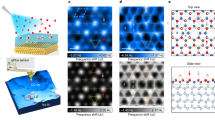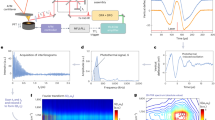Abstract
The nature of non-crystalline materials causes the local potential energy of a cluster of atoms or molecules to vary significantly in space. Different configurations of an ensemble of atoms in a metallic glass lead therefore to a distribution of elastic constants which also changes in space. This is totally different to their crystalline counterparts, where a long-range order exists in space and therefore a much more unified elastic modulus is expected. Using atomic force acoustic microscopy, we present data which show that the local so-called indentation modulus M indeed exhibits a wide distribution on a scale below 10 nm in amorphous PdCuSi, with Δ M/M≈30%. About 104 atoms are probed in an individual measurement. Crystallized PdCuSi shows a variation that is 10–30 times smaller and which is determined by the resolution of the microscope and by the polycrystalline structure of the material.
This is a preview of subscription content, access via your institution
Access options
Subscribe to this journal
Receive 12 print issues and online access
$259.00 per year
only $21.58 per issue
Buy this article
- Purchase on Springer Link
- Instant access to full article PDF
Prices may be subject to local taxes which are calculated during checkout


Similar content being viewed by others
References
Srolovitz, D., Maeda, K., Vitek, V. & Egami, T. Structural defects in amorphous solids: Statistical analysis of a computer model. Phil. Mag. A41, 847–866 (1981).
Johnson, W. L. & Samwer, K. A universal criterion for plastic yielding of metallic glasses with a (Tf/TG)2/3 temperature dependence. Phys. Rev. Lett. 95, 195501 (2005).
Mayr, S. G. Activation energy of shear transformation zones: A key for understanding rheology of glasses and liquids. Phys. Rev. Lett. 97, 195501 (2006).
Pan, D., Inoue, A., Sakurai, T. & Chen, M. W. Experimental characterization of shear transformation zones for plastic flow of bulk metallic glasses. Proc. Natl Acad. Sci. USA 105, 14769–14772 (2008).
Schwabe, M., Küchemann, S., Wagner, H., Bedorf, D. & Samwer, K. Activation volume of microscopic processes in amorphous Pd77.5Cu6.0Si16.5 due to stress and temperature. J. Non-Cryst. Solids 490–493 (2011).
Bedorf, D. & Samwer, K. Length scale effects on relaxations in metallic glasses. J. Non-Cryst. Solids 356, 340–343 (2010).
Rabe, U. et al. Imaging and measurement of local mechanical material properties by atomic force acoustic microscopy. Surf. Interface Anal. 33, 65–70 (2002).
Vlassak, J. J. & Nix, W. D. Indentation modulus of elastically anisotropic half-spaces. Phil. Mag. A 67, 1045–1056 (1993).
Kopycinska-Müller, M. et al. Quantitative evaluation of elastic properties of nanocrystalline nickel using atomic force acoustic microscopy. Z. Phys. Chem. 222, 471–498 (2008).
Yuya, P. A., Hurley, D. C & Turner, J. A. Contact-resonance atomic force microscopy for viscoelasticity. J. Appl. Phys. 104, 077916 (2008).
Caron, A. & Arnold, W. Observation of local internal friction and plasticity onset in nanocrystalline nickel by atomic force acoustic microscopy. Acta Mater. 57, 4353–4363 (2009).
Liu, L., Pang, S. J., Ma, C. L. & Zhang, T. Effect of minor Au addition on glass-forming ability and mechanical properties of Pd–Cu–Au–Si–P alloys. Mater. Trans. 46, 2945–2948 (2005).
Johnson, K. L. Contact Mechanics (Cambridge Univ. Press, 1985).
Kumar, A., Rabe, U., Hirsekorn, S. & Arnold, W. Elasticity mapping of precipitates in polycrystalline materials using atomic force acoustic microscopy. Appl. Phys. Lett. 92, 183106 (2008).
Bellessa, G. & Bethoux, O. Sound propagation in amorphous metallic Pd–Si at low temperatures. Phys. Lett. 62A, 125–126 (1977).
Measurements were carried out by Yuya P. & Turner J. A., Department of Engineering Mechanics, University of Nebraska at Lincoln, NE, USA (2010).
Alexander, S. Amorphous solids: Their structure, lattice dynamics and elasticity. Phys. Rep. 296, 65–236 (1998).
Stillinger, F. H. & Weber, T. A hidden structure in liquids. Phys. Rev. A 25, 978–989 (1982).
Stillinger, F. H. A topographic view of supercooled liquids and glass formation. Science 31, 1935–1939 (1995).
Harmon, J. S., Demetriou, M. D., Johnson, W. L. & Samwer, K. Anelastic to plastic transition in metallic glass-forming liquids. Phys. Rev. Lett. 99, 135502 (2007).
Neudecker, M. & Mayr, S. G. Dynamics of shear localization and stress relaxation in amorphous Cu50Ti50 . Acta Mater. 57, 1437–1441 (2009).
Egami, T. & Srolovitz, D. Local structural fluctuations in amorphous and liquid metals: A simple theory of the glass transition. J. Phys. F 12, 2141–2163 (1982).
Tsamados, M., Tanguy, A., Goldenberg, C. & Barat, J. L. Local elasticity map and plasticity in a model Lenard–Jones glass. Phys. Rev. E 80, 026112 (2009).
Greenwood, J. A. & Tripp, J. H. The elastic contact of rough spheres. Trans. ASME, J. Appl. Mech. 34, 153–159 (1967).
Acknowledgements
We thank P. Yuya and J. Turner, University of Nebraska at Lincoln, for carrying out nano-indentation measurements on our PdCuSi samples. B.Z. thanks the Alexander von Humboldt Foundation for support with a post-doctoral fellowship. W.A. thanks M. Kopycinska-Müller for discussions. This work was supported by the German Science Foundation within the ‘SFB 602’ and the Leibniz-Program (Sa 337/10-1).
Author information
Authors and Affiliations
Contributions
H.W. carried out the experiments, analysed the data, and contributed to writing the paper. W.A. devised the experiment, wrote part of the paper, and analysed the data. S.K. provide the global elastic data. D.B. wrote part of the paper and analysed the data. M.S. prepared the samples. B.Z. continued with the measurement after H.W. left. K.S. wrote part of the paper and supervised the team.
Corresponding author
Ethics declarations
Competing interests
The authors declare no competing financial interests.
Supplementary information
Rights and permissions
About this article
Cite this article
Wagner, H., Bedorf, D., Küchemann, S. et al. Local elastic properties of a metallic glass. Nature Mater 10, 439–442 (2011). https://doi.org/10.1038/nmat3024
Received:
Accepted:
Published:
Issue Date:
DOI: https://doi.org/10.1038/nmat3024
This article is cited by
-
Ripples in the bottom of the potential energy landscape of metallic glass
Nature Communications (2024)
-
Unveiling the time-temperature dependence of metastability of supercooled liquid using nano-calorimetry
Science China Physics, Mechanics & Astronomy (2024)
-
Influence of oscillation strain on the dynamic mechanical relaxation of a La-based metallic glass
Science China Technological Sciences (2023)
-
Liquid-like atoms in dense-packed solid glasses
Nature Materials (2022)
-
Fatigue fracture mechanism of amorphous materials from a density-based coarse-grained model
Communications Materials (2022)



